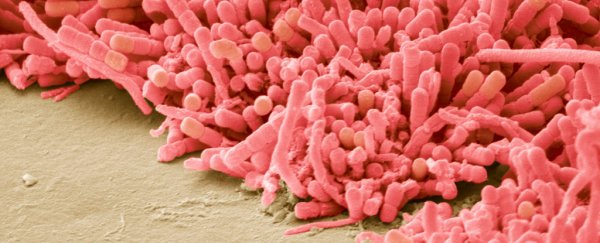Bacteria aren't well known for their smarts. They grow, they adapt, and they grow some more, but we don't usually catch them remembering things.
Now, researchers from the University of California (UC), San Diego, have used light to imprint a 'memory' on a bacterial biofilm – and discovered that the microbes acted surprisingly similarly to neurons.
"Our work shows for the first time that simple bacteria can encode memory at the level of their cellular membrane potential, which is similar to the memory process of neurons in the brain," UC San Diego molecular biologist Gürol Süel told ScienceAlert.
"We were surprised to find that the mechanism by which the memory is formed, is similar between bacteria and neurons, since these are evolutionary very distant systems."
When neurons 'fire' in our brains, ions flood into the tiny gap between nerve cells, telling the next neuron that a message has been received, and triggering it to continue passing on that message.
The flood of ions produces a cellular membrane potential - a difference in electrical charge between the inside and outside of the cell. Pretty much all living things use this phenomenon to power mechanisms in the cellular membrane and to transmit signals between different areas of the body.
In neurons, this change in cellular membrane potential is known to be involved in the process of memory formation; now, it seems that something similar can happen in biofilms.
"This membrane potential is a fundamental property shared by all living cells, and particularly well-studied in neurons," Süel explained.
"Bacteria that were exposed to light, persistently exhibited a different membrane potential compared to those bacteria that were not exposed, thus it was clear that these bacteria 'remembered' being exposed to light."
The team looked at a simple bacterial species called grass bacillus (Bacillus subtilis) and gave them a five second blast of blue light from a laser. They found this light causes a change in the membrane potential – with ions constantly flooding out of the cell, and then back in again. This effect stuck around for several hours after the light exposure.
"The models are well executed, as is the experimental work with microfluidics and light excitation. Some sections are less convincing," says evolutionary biologist Olin Silander from Massey University Auckland in New Zealand, who was not involved in the study.
"The authors suggest that one gene (yugO) is a potassium channel necessary for light stimulation to work in biofilms. However, other authors have noted that yugO is actually necessary for biofilms to form at all."
Because the bacteria had been genetically engineered to fluoresce when the concentration of membrane potential reporter thioflavin-T rises, the research team was able to physically watch the biofilm as it pulsed.
"The light-exposed cells transition back and forth from being hyperpolarised to becoming depolarised, relative to the rest of the biofilm," the researchers write in the paper. "This results in striking visual patterns over time."
You can see this in this video below.

Although it appears to be a type of memory formation, it's definitely not the same as what goes on in our brains. We don't yet know why it occurs or whether the bacteria actually use it in their regular environments.
"We do not know yet why bacteria have this property. Clearly we need to study more deeply what it means for bacteria to be exposed to light and form memories," Süel explains.
The researchers say their results allude to the idea that the neurons we rely on might have some processes that reach as far back into our evolutionary history as bacteria, although not everyone is convinced.
"The homology of these two processes is unlikely; that is, it is not likely that they both evolved from one ancestral potassium or other cation channel," Silander told ScienceAlert.
"Although there are many other processes/behaviours in bacteria known to exhibit memory, this is the first that I know of that results from light-stimulus."
Indeed, this isn't the first time researchers have found bacteria that 'remember' stuff.
A few years ago, a different team of researchers found that bacteria had a collective memory which increased their tolerance to stress when exposed to salt.
The current team of researchers hopes that they may be able to use their findings for biological computation and synthetic biology, but that's a long way off yet.
In the meantime, treat your body's bacteria well… it might just remember.
The research has been published in Cell Systems.
Editor's note (29 Apr 2020): The article has been updated with comments from a researcher who was not involved in the study.
